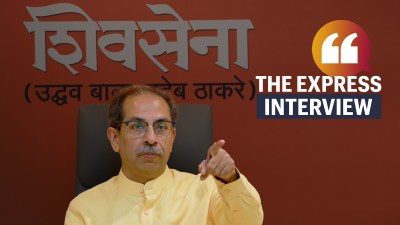- India
- International
Covid-19 pandemic now in community transmission stage in India: what does this mean?
India has acknowledged that the Covid-19 pandemic is now in the community transmission stage. How is this stage defined, and what are its implications? What changes in strategies to contain the spread?
 A crowd in New Delhi's Sarojini Nagar market last month, by when the Omicron variant of the coronavirus was already spreading. (Express Photo: Tashi Tobgyal)
A crowd in New Delhi's Sarojini Nagar market last month, by when the Omicron variant of the coronavirus was already spreading. (Express Photo: Tashi Tobgyal)In the third wave of the coronavirus epidemic, India has acknowledged that the disease is now in the community transmission stage. While it is no more than a statement of the obvious, and has little operational implication at this stage of the epidemic, this acknowledgment has attracted attention because this is the first time India has officially done so.
What it means
In all regions except the origin of the outbreak, the virus is introduced into the population by travellers. In the initial stages of an epidemic, all further transmissions of the disease can be linked, directly or through a chain, to these travellers. But after some time, as more and more people get infected, they pass on the virus to many more, several of whom are never detected because they might be asymptomatic or did not get tested. But even these undetected cases would have transmitted the disease to others. Very soon, it results in a situation where the chain of infections can no longer be traced to the original travellers, and most of the infections become locally acquired. It is this stage of the epidemic that is classified as one of community transmission.
In simple terms, it is a stage where it becomes difficult to establish the chain of infections, or determine who infected whom. This has implications for deciding containment strategies and response measures to deal with the epidemic.
Community transmission is the final stage of classification of the epidemic on this basis. The World Health Organization (WHO) has three more classifications ahead of community transmission — no active cases, sporadic cases and cluster of cases. If no new cases are detected in 28 days, a country or region is said to have no new active cases. A situation where all the known infections in the previous two weeks can be linked to an imported case is classified as being in the second category.
India had so far been maintaining that the epidemic in the country was in the stage where it was witnessing a cluster of cases. According to the WHO classification, this is the stage where cases detected in the previous two weeks are “predominantly limited to well-defined clusters that are not directly linked to imported cases, but which are all linked by time, geographic location and common exposures”. It is assumed that there are a large number of unidentified cases, but this is still considered a low-risk situation.

The manner in which the transmissions are happening is key to deciding actions to be taken to contain further spread of the disease. In the initial stage for example, when only sporadic cases are detected, aggressive testing and contact tracing is supposed to be among the most effective strategies to halt or slow down the spread of the disease. As all direct contacts of an infected person are identified, tested and isolated, the number of virus-carrying people in the population gets reduced significantly, and so does the number of transmissions.
However, such a strategy might not yield much in terms of slowing down the spread in the community transmission stage. In such a situation, it is considered more beneficial to focus attention on measures like hospital management, access to critical care facilities or genomic surveillance.
Current situation
The recent acknowledgment, made in the latest bulletins released by INSACOG, a network of laboratories that is tasked with genome surveillance, does not reveal anything new. India is known to have entered the community transmission phase within a couple of months of the start of the pandemic in 2020 itself.
From the speed at which the Omicron variant has spread, there never was any doubt that community transmission was taking place. Even before Omicron, India was detecting only one of about 30 infections. Now, this ratio would have shot up even further. At this stage of the epidemic, a discussion on community transmission is largely an academic one, and is unlikely to trigger any change in the kind of response measures that are being taken at the central, state or local levels.
Looking ahead
Since the current wave is producing mostly mild disease, experts argue that a containment strategy might not yield much, especially since the infection was spreading at such a fast rate, and mainly through asymptomatic cases. Instead, it would be better to focus attention on surveillance, with the objective of keeping an eye on future dangerous mutations.
“We should change the strategy of sample collection for genome sequencing. There is no point in focusing on airports. A close watch should, instead, be kept on clinical samples from the ICU or those with serious symptoms to check if there is further mutation of the SARS-CoV-2 virus and whether it is changing a bit. There is a need to keep an eye on clusters at localities or parties or any gathering in case there is a sudden eruption of cases and also ensure a randomised sampling in large areas,” said Rakesh Mishra, former director of Centre for Cellular and Molecular Biology.
Mishra said testing and tracking contacts could not prevent the further spread of the Omicron variant at this stage, even though it was still important to test as many as possible. “But the main focus must be on the hospitalised cases, and those who have developed severe illnesses,” said Mishra, who is director of Tata Institute of Genetics and Society.
Several states have already changed their testing strategy and have not been aggressively doing contact tracing, especially those who are not showing symptoms.
Dr Shashank Joshi, member of Maharashtra’s Covid-19 task force, said the focus must be on saving lives, because such a large number of cases can overwhelm hospitals. “What is known from the current wave is that it has come in a very explosive and tsunami-like proportion. It is more like a cyclone and not a wave. As 80-90% people are asymptomatic, our focus is directed on symptomatic patients. Those who are unvaccinated, or only partially vaccinated, are in the high-risk category. And so are people with chronic underlying diseases like cancer, heart transplantation or lung disease. The focus clearly is to save lives and ensure health systems are prepared,” Dr Joshi said.
Maharashtra surveillance officer Dr Pradeep Awate said health authorities were no longer tracking every contact of an infected person. “We are already moving on to the endemic stage. Genomic sequencing however will be necessary as Omicron may not be the last variant,” he said.
Newsletter | Click to get the day’s best explainers in your inbox
More Explained
EXPRESS OPINION
Apr 20: Latest News
- 01
- 02
- 03
- 04
- 05









































